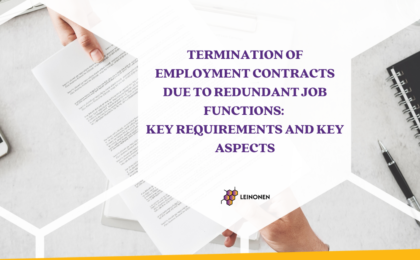Will the employers be obliged to amend the existing employment contracts after NLC comes into force?
The revision of the existing employment contracts is not necessary, it may be useful though. Leinonen team recommends the clients to review the existing employment contracts in order to achieve more clarity in the legal matters of the employment relations. Below we identify key aspects to take into consideration when reviewing the existing employment contracts. We note that the list set out is not exhaustive since the employment contracts of the companies are different.
The revision / amendment of the employment contracts:
The amount of the work time. Based on NLC the amount of work time must be clearly defined in the employment contracts (i.e. the accurate number of working hours must be indicated). The amount of work time shall be indicated as the working hours per week, working hours per day or other accounting period.
Non-competition. First, employers should pay attention to the employment contracts of those employees, which have obligated not to compete with the company. Part of the employers were paying the compensations for non-competing before NLC came into force, now, however, it is important to note that the amount of compensation for non-competition is regulated by NLC. The amount of compensation for non-competition shall not be less than 40 percent of the average monthly salary paid to the employee.
Annual Leave. The annual leave is being counted in working days according to NLC. There are cases when the duration of annual leave is specified in exact number of days in the employment contract. Our recommendation is to amend the employment contract so that the annual leave would be provided according to the valid legal acts.
Compensation of the learning costs. It is worth paying attention, that the parties may agree on the compensation that the cost of the employee’s learning and improvement of the qualification, which were incurred by the employer during the last 2 years, when the employment contract is terminated upon the employee’s will or the will of the employer for the fault of the employee. By enclosing the appropriate wording of the provision into the employment contract may grant the employer a right to claim to the compensation of the additional expenses related to the employee’s learning (for example, travel and accommodation costs). The amendments of the existing employment contracts might be favourable for the employers which invest in the staff development.
Confidentiality Agreement. NLC provides the ability to agree on forfeit for the violation of the confidentiality agreement. In the light of the fact that this regulation is new, it would be worthwhile to complement the existing employment contract including a confidentiality agreement with a provision of forfeit for violation thereof.
Is the amount of the fixed-term employment contracts in the company limited?
The fixed-term employment contracts were suitable only for the works that had not any features of the constancy (e.g. substitution of the employee on parental leave, etc.) before NLC came into force. NLC provides the ability to conclude the fixed-term employment contracts with the employees whose work is of constant manner. However, the number of fixed-term employment contracts in the company may not exceed 20 percent of the total number of contracts concluded in the Company.
What types of internal documents shall be drafted?
NLC establishes an obligation to prepare new Internal Rules and Policies in the companies. We list the main documents that companies shall prepare and enforce due implementation in the table below.
Document | Average number of employees 20 and more | Average number of employees 50 and more |
The procedure of usage of the information and communication technologies, monitoring of employees and control in the work place | + | + |
Scheme of payment for work | + | + |
The policy of equal opportunities |
| + |
The policy of personal data protection |
| + |
There shall be listed in the scheme of payment for work the categories of the employees according to their positions and qualifications, the ways of payments and amounts of payments (minimum and maximum), the grounds and order of allotting the additional payment (bonuses), salary indexation system.
What should be defined in the Internal Rules?
According to NLC there are no strict requirement set for the companies to have the Internal Rules. However, it shall be prepared if the employer aims to protect its own interests or the ones of the employees. We would like to inform you that the information indicated below should be renewed in the companies’ Internal Rules:
- a plan of improving work results of the employees;
- the procedure of election of the work board (this is obligatory for the companies having 20 employees or more);
- the list of administration workers;
- the order of submitting the remarks for the violations of the duties;
- provision of the information to the employees using electronic means of communication;
- other information.
Has the employee the right to choose the days-off instead of payment for the overtime or work on national holidays?
Yes, according to Article 144 Part 5 of NLC the employee has the right to choose the day-off. The time of work on days-off or national holidays or overtime may be added to the annual leave by multiplying the time by its coefficient.
Are the bonus included to the average monthly salary of the employee?
In those cases when the employee according to NLC, other labour law regulations or employment contract is paid the average monthly salary (or part of it), which is based on the previous monthly salary, the calculation of this average monthly salary does not include the bonus, that are awarded by the employer on its initiative in order to encourage the employee for the work well done, results achieved and activities carried out by him, the company, the undertaking or the group of the employees.
We emphasize that bonuses which the employer has obligated to pay according to the employment contract or other internal documents are included into calculation of the average monthly salary. It is important that the procedure of payment of such bonuses shall be clearly established in the employment contract or other internal documents of the company.
How should the unused annual leave be recalculated?
As we have mentioned above NLC counts the annual leave in working days. The annual leave of 20 working days is provided for those employees working 5 working days per week. The annual leave of 24 working days is provided for those employees working 6 working days per week. The following formula is applied for recalculating the unused annual leave:
- the unused annual leave multiplied by 5 and divided in 7 (for working week of 5 days);
- the unused annual leave multiplied by 6 and divided in 7 (for working week of 6 days).
Noteworthy, in case the calculated number of leave days is not a whole number, the part of the day counts as a whole day (i.e. the number after comma shall be rounded up for the benefit of the employee).
The annual leave of not less than four weeks shall be provided to those employees whose number of working days per week is lower than the above-mentioned ones or differs depending on week.
The main changes in the employment law are listed in the following table.
TILL 30 JUNE 2017 | FROM 1 JULY 2017 | |
1. TYPES OF THE EMPLOYMENT CONTRACT | ||
Types |
|
|
1.1. FIXED TERM EMPLOYMENT CONTRACT | ||
Duration term |
|
|
Notice period for expiration |
|
|
Compensation |
|
|
For the permanent positions |
|
|
| – |
|
| – |
|
1.2. TEMPORARY WORK EMPLOYMENT CONTRACT | ||
Main touch points |
|
|
| – |
|
Notice on termination of employment contract | – |
|
| – |
|
1.3. EMPLOYMENT CONTRACT FOR PROJECT WORK | ||
Main touch points |
|
|
1.4. JOB-SHARING EMPLOYMENT CONTRACT | ||
Main touch points |
|
|
1.5. EMPLOYMENT CONTRACT WITH SEVERAL EMPLOYERS | ||
Main touch points |
|
|
1.6. APPRENTICESHIP EMPLOYMENT CONTRACT | ||
Main touch points |
|
|
– 1.7. SEASONAL WORK EMPLOYMENT CONTRACT | ||
Main touch points |
|
|
FEE FOR PAYMENT FUND OF LASTING WORK | ||
Main touch points |
|
|
2. TERMINATION OF THE EMPLOYMENT CONTRACT | ||
2.1. ON THE INITIATIVE OF THE EMPLOYER WITHOUT THE FAULT OF THE EMPLOYEE | ||
Reasons of termination |
|
|
Notice period |
|
|
Severance pay | The employer pays:
| The employer pays:
The special state fund pays:
|
2.2. DISMISSAL ON THE EMPLOYER’S WILL | ||
Reasons and compensation |
|
|
2.3. UNDER THE MUTUAL AGREEMENT OF THE PARTIES | ||
Period to make a decision |
|
|
2.4. ON THE INITIATIVE OF THE EMPLOYEE WITHOUT ESSENTIAL REASONS | ||
Notice period |
|
|
2.5. ON THE INITIATIVE OF THE EMPLOYER ON THE FAULT OF THE EMPLOYEE | ||
Reasons |
|
|
| – |
|
3. NON-COMPETE | ||
3.1. THE NON-COMPETITION AGREEMENT | ||
Main touch points |
|
|
4. MATERIAL LIABILITY OF THE EMPLOYEES | ||
The Full Material Liability Agreement |
|
|
Limits of employee’s liability |
|
|
5. REPRESENTATION OF THE EMPLOYEES | ||
5.1. WORK COUNCIL | ||
Establishment of the Work Council |
|
|
Functions |
|
|
6. WORKING TIME, REST TIME, PAYMENT SYSTEM | ||
Holidays |
|
|
Holiday pay |
|
|
Overtime |
|
|
Pay for overtime during public holidays |
|
|
| – |
|
Working time mode |
|
|
Teleworking |
|
|
Limitation of working time on night shifts | – |
|
Minimum wage |
|
|
7. SUMMARY RECORDING OF WORKING TIME | ||
Period |
|
|
Working time schedules |
|
|
Pay for Idle time |
|
|
8. ADDITIONAL AGREEMENTS IN THE EMPLOYMENT CONTRACTS | ||
Compensation of training expenses |
|
|
Confidentiality agreement |
|
|
Agreement on different work conditions |
|
|
Agreement on passive duty |
|
|
Should you have further questions regarding the new Labour Code, please do not hesitate to contact us:
Živilė Morkūnaitė
Lawyer
email: zivile.morkunaite@leinonen.lt
tel.: +370 656 73318




